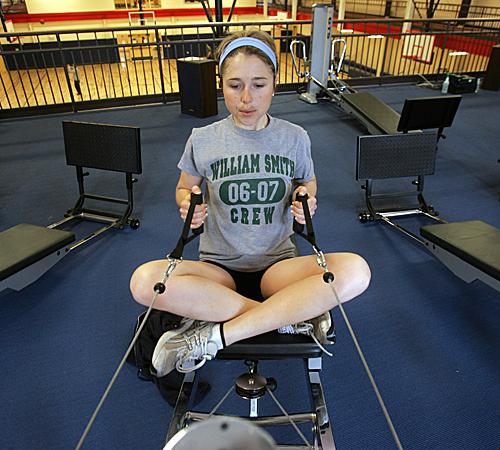Gravity machines make play for space in gyms

William Staigar exercises on a Gravity machine at the YMCA in Saratoga Springs, N.Y., Thursday, April 5. Gravity equipment has become popular here and in other clubs. The $17.6 billion health club industry is always on the lookout for the next thing, esp Mike Groll, AP
May 1, 2007
Last updated on May 12, 2016 at 11:39 a.m.
SARATOGA SPRINGS, N.Y. – America might not need yet another exercise machine. Treadmills, weights and resistance equipment already jam the health clubs.
Yet Gravity machines have found a niche at the YMCA in this resort town. On a recent weekday morning, a dozen women and men push, pull and grunt on the machines’ slanted glideboards. They push with their legs, then pull with their arms – up and down diagonally.
“Keep those legs up!” trainer Yonka Perkins tells her straining students. “Keep those glutes nice and tight!”
The $17.6 billion health club industry is always open to something new. The YMCA is one of roughly 30 health clubs in the United States to add Gravity machines since the start of the year. It’s not clear if this relatively new device will lead to a hot new trend like Spinning, a popular indoor cycling program, but so far it offers a glimpse into an industry always looking to entice exercisers with new ways to stay tone and trim.
Get The Daily Illini in your inbox!
“We’re always looking for ways to make exercise more effective, more fun, less time, more pop for your time,” said Brooke Correia of the International Health, Racquet and Sportsclub Association.
Gyms have come a long way since the low-tech days of Indian clubs and medicine balls. Rudimentary machines like the motorized belts that jiggled users’ bellies have given way to sophisticated machines that keep tabs on cardiovascular activity and simulated distance.
Gravity equipment competes for precious floor space not only with standbys like StairMasters and Pilates equipment, but with newer machines that feature everything from video screens to vibrating bases. Gravity’s hook is that it can offer a range of cardio and strength-training exercises – you can even do Pilates on it – in a relatively short period of time. The track is adjustable; the steeper the incline, the harder the workout.
“It’s very intense,” said Joanne Leiser after a 30-minute workout at the Saratoga YMCA. “It’s quick, and it’s cool.”
The machines were introduced in 2003 by San Diego-based efi Sports Medicine, creator of the Total Gym. Jesse Campanaro, national sales manager, said sales have been brisk recently, climbing from 130 clubs to more than 160 in the United States since the start of the year.
These are small numbers compared to the estimated 12.65 million people who used resistance machines in 2005, or the 10.5 million who ran on treadmills. But as Campanaro put it, “We’re getting a lot more traction.”
The machines are essentially a health club version of the company’s less expensive Total Gym, a home and rehabilitation machine known to many for the television infomercials featuring martial arts actor Chuck Norris confidently gliding up and down slantwise.
No infomercials for Gravity, though the system has clearly benefited from the enthusiasm of health club fitness trainers. Jon D’Alessio, group fitness director at The Jungle Club in Vero Beach, Fla., said it’s a fast, efficient way to provide both personal training or group sessions. To keep the interest of men, he developed exercises that simulate golf swings and kayak paddling.
“It’s much more fun than whatever else I’ve been doing for the last 15 years,” he said.
The machines are often given studio space for group classes of up to a dozen.
The Saratoga YMCA placed its machines in a semicircle inside the hairpin bend of the indoor track, where Perkins regularly leads group sessions there to the beats of Beyonce and Shakira. “It’s not beating the heck out of your body,” said student Lori Tynan. “The machine keeps everything smooth.”





